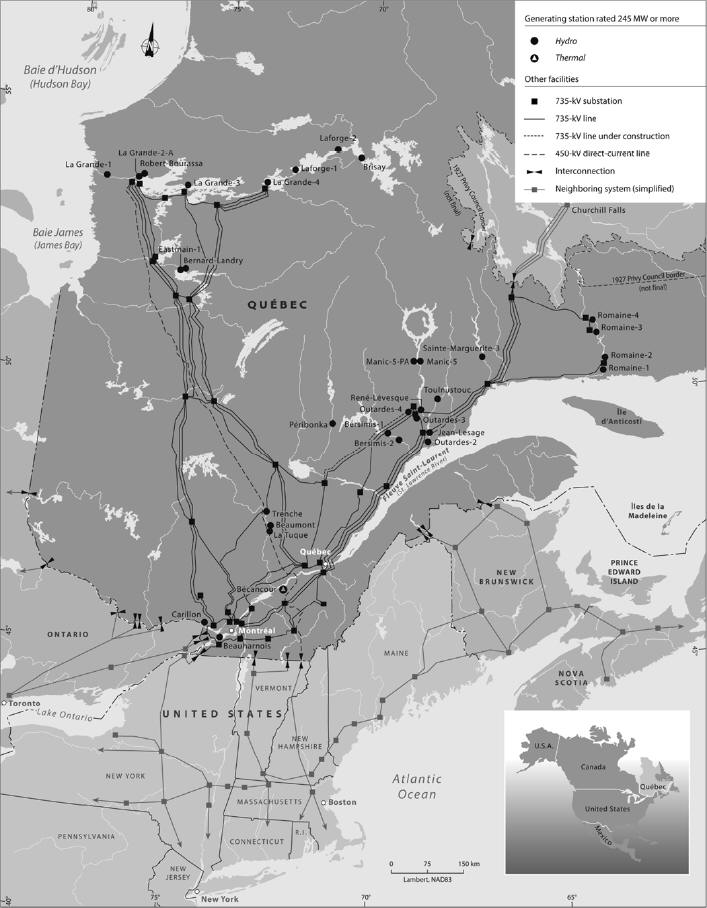CONSOLIDATED RESULTS
Net income
In a context marked by a sharp increase in energy prices on export markets and cold winter temperatures at the beginning of the year, net income reached $4,557 million, an increase of $993 million compared to the $3,564 million recorded the previous year. This growth is attributable to an increase in electricity sales, both in and outside Québec, partially offset, however, by an increase in electricity purchases.
On markets outside Québec, electricity sales rose by $1,086 million, mainly as a result of a sharp increase in the average price obtained. Export volume reached 35.6 TWh, comparable to a year earlier.
In Québec, electricity sales set a record of 180.6 TWh, an increase of 5.4 TWh compared to the previous year, bringing in $912 million more than in 2021, due to several factors. First, temperatures led to an increase of 3.0 TWh or $258 million. Their effect was mainly felt in January, when they were 7°C lower, on average, than in 2021. Second, baseload demand rose by 2.4 TWh or $202 million as a result of growth in energy consumption in most segments, especially among residential customers and in the commercial, institutional and small industrial segment. Lastly, the increase in aluminum prices drove up electricity sales by $211 million, while the indexation of rates as of April 1, 2021 and 2022, had a favorable impact of $239 million.
Electricity purchases rose $665 million due to three factors: an increase in short-term supplies purchased on the markets to meet Québec’s ad hoc requirements during the cold spell at the beginning of the year; higher transmission costs related to sales outside Québec partly due to the sharp spike in energy prices on the markets; and a higher supply volume, resulting in part from the coming into force of new power purchase agreements.
Revenue
Revenue totaled $16,567 million, compared to $14,526 million a year earlier. Revenue from ordinary activities reached $16,369 million, compared to $14,363 million in 2021. Electricity sales amounted to $16,143 million, or $1,998 million more than the $14,145 million recorded the previous year. This marked increase is due to a $912-million rise in electricity sales in Québec and a $1,086-million spike in electricity sales on markets outside Québec. Other revenue from ordinary activities increased by $8 million, and revenue from other activities, by $35 million.
Revenue from ordinary activities
Electricity sales in Québec
In Québec, electricity sales rose by 5.4 TWh to a historic peak – 180.6 TWh – contributing to a $912-million increase in related revenue, resulting from the combined effect of four factors, with a practically equivalent impact.
First, temperatures had a favorable impact of 3.0 TWh or $258 million. First-quarter temperatures were colder in 2022 than 2021, leading to an increase of 3.6 TWh or $311 million. The impact on sales was especially significant in January – the coldest since 2004 – when temperatures were 7°C lower, on average, than in 2021. On the other hand, December’s temperatures were milder in 2022 than 2021, resulting in a decrease in sales of 0.8 TWh, or $70 million compared to the previous year.
Second, baseload demand rose by 2.4 TWh or $202 million due to the increase in energy needs, mainly in the residential segment, where demographic change led to a natural growth in the number of customer accounts, and in the commercial, institutional and small industrial segment, which benefited from renewed vigor in the Québec economy. It should be noted that the first half of 2021 was marked by the enforcement of public health measures related to the management of the pandemic, including the closure of many stores and other businesses for several months during winter and spring, which exerted downward pressure on electricity sales.
Third, the increase in aluminum prices, which have an effect on revenue from some special contracts, led to a $211-million increase in revenue from electricity sales in Québec.
Fourth, the rate indexations that came into effect on April 1, 2021 and 2022, pursuant to An Act to simplify the process for establishing electricity distribution rates, translated into a $239-million increase in revenue.
- 29 -

